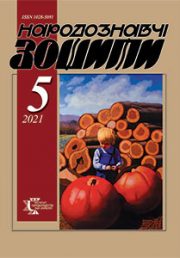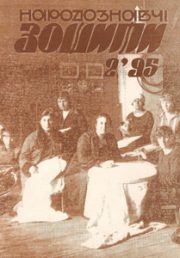The Ethnology Notebooks. 2023. № 4 (172), 1050—1060
UDK 39:[738:666.3-187](477+438+474.5+476)”19/20″’
DOI https://doi.org/10.15407/nz2023.04.1050
MOTYL Romana
- ORCID ID: http://orcid.org/0000-0001-6936-0328
- Candidate of Arts (Ph.D), Associate Professor,
- Department of Design and Architecture Fundamentals,
- Lviv Polytechnic National University,
- 12, Bandery St., 79000, Lviv, Ukraine;
- Senior Researcher Folk Art Department,
- Ethnology Institute of NAS of Ukraine,
- 15, Svobody ave., 79000, Lviv, Ukraine,
- Contacts: e-mail: romana_motyl@ukr.net
Abstract. Introduction. The article is devoted to one of the most important processes in the manufacture of smoked ceramics — firing. The main role in creating the characteristic black color of ceramics is played by a special firing technology, when an oxygen-free environment is created in the kiln by closing all the holes tightly. The production of smoked ceramics is known in many countries of the world, but the most common features in firing traditions are observed in geographically close lands, namely Ukraine, Poland, Lithuania, and Belarus.
Therefore, the purpose of the study is to analyze and compare the peculiarities of firing smoked ceramics in each of these countries on the example of operating kilns of the late 20th and early 21st centuries. Particular attention is paid to the construction of the kilns, the main stages of firing in an oxygen-free environment, as well as the causes of black and gray coloration on the surface of pottery. Common and distinctive features in the firing of smoked ceramics from Ukraine, Poland, Lithuania, and Belarus are identified.
The methodology of the work consists in the application of a comprehensive methodology, which is formed from a combination of a number of scientific methods: comparative-historical, structural-typological, analytical-descriptive, figurative and stylistic analysis.
Results. Using the examples of the activities of individual potters, the article traces the peculiarities of the kiln firing of smoked ceramics in Ukraine (Serhiy Ivashkiv), Poland (Pawel Pechowski), Lithuania (Teresa Jankauskaite), and Belarus (Dmytriy Kaptura).
Comparing the methods of firing smoky ceramics in the late 20th and early 21st centuries in Ukraine, Poland, Lithuania, and Belarus, it was found that potters in each of the countries represented adhere to the traditional technology, which includes the following stages: loading and heating the kiln, gradually increasing the temperature, supervising the fired products, and reaching the maximum temperature. The main feature of reduction firing is also common, which is the closure of air access to the furnace in the final phase. However, the peculiarities of «sealing» the kiln and the process of smoked firing are different and specific both in each country and in the practice of each individual craftsman.
The most significant differences in firing smoked ceramics in Ukraine, Poland, Lithuania, and Belarus relate to such characteristics as clay composition, the construction and size of kilns, differences in the firing process itself (time, method of laying products in the chamber, maximum temperature, the final firing phase, including the «sealing» of the kiln), and the quality, quantity, and grade of fuel.
Conclusion. All of the unique and universal features of the smoked ceramics firing process in Ukraine, Poland, Lithuania, and Belarus affect the quality and artistic appearance of the products, and further research and preservation of the ethnic traditions of the art of ceramics production will contribute to a better understanding of the phenomenon of national identity in each country.
Keywords: firing, kiln, oxygen-free environment, smoked ceramics, pottery, Ukraine, Poland, Lithuania, Belarus.
Received 1.07.2023
REFERENСES
- Werner, E., & Klusch, Horst. (Ed.). (1981). «On the origin and chemical structure of «black-colored pigments in unglazed earthenware». Reports and papers. 13 international Hafnerei — Symposion, 1980 (Pp. 215—232). Sibiu [in German].
- Reinfuss, R. (1955). Folk pottery. Warsaw: Sztuka [in Polish].
- Wowak, Y. (2014). Grey and Black Ceramics of the Polish-Lithuanian Borderland. Glass and Ceramics, 6, 16—20 [in Polish].
- Sakhuta, Ya.M. (2001). Belarusian Folk Decorative and Applied Arts. Minsk: Belarus [in Belarusian].
- Szabadfalvi, Jozsef. (1987). Hungarian Black Pottery. Budapest: Corvina.
- Duma, G. (1962). The Development of Colour on Unglazed Black Pottery with Coal Dust Added. Epitoanyag 12 (P. 45).
- Floera, B., & Floresku. (1958). Black polished ceramics from Marginea. Bucarest: de Stat pentru Literatura si Arta [in Romanian].
- Poverіn, A. (2002). Pottery. Black-polished Ceramics. Moscow: Culture and Traditions [in Russian].
- Motyl, R. (2011). Ukrainian Smoked Ceramics of the 19th and early 21st Centuries. History. Typology. Artistic features. Lviv: Institute of Ethnology of the National Academy of Sciences of Ukraine [in Ukrainian].
- Matuszczyk, M., & Wowak, J. (2015). Terese Jankauskaite. Black Ceramics from Lithuania. Catalog of the exhibition Terese Jankauskaite «Black Ceramics from Lithuania». Wroclaw: ASP [in Polish].
- Matuszczyk, M., & Wowak, Y. (2015). Elvyra Terese Petraitiene and Her Legends Told with Clay. Silhouette and Works of the Artist. Glass and Ceramics (Pp. 6—7). [in Polish].
- Motyl, R. (2020). International Symposium of Ceramics in Lelunai (Lithuania): Traditions, Artistic Search, and Achievements. Ethnological notebooks, 1 (151), 138—146 [in Ukrainian].







